- Author: Mike Hsu
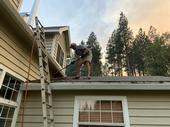
Despite recent rains, fire remains a danger across California, as there's still plenty of time this fall for grass, woody debris and other flammable material to become dry and ignite.
“The smaller the fuels – pine needles, grass, and small twigs – the faster they can dry out, meaning they will be ready to burn again a few days or weeks after a large rainstorm,” said Susie Kocher, a UC Cooperative Extension forestry and natural resources advisor for the Central Sierra, urging residents to take steps to prevent or limit potential fire damage.
When it comes to “home hardening”...
- Author: Susie Kocher
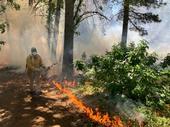
The new El Dorado/Amador Prescribed Burn association, formed in August 2021, has conducted several burns with private landowners and received funding for a part-time coordinator.
A new group of local residents dedicated to helping private landowners conduct prescribed burns on their own properties has formed in El Dorado and Amador Counties. The group was convened by Susie Kocher, forestry advisor for the University of California Cooperative Extension in the Central Sierra.
“Prescribed Burn Associations, or PBAs, are groups of landowners helping each other to both learn how to use prescribed fire to manage their properties and to...
- Author: Susan Kocher and Ryan Tompkins
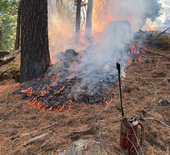
Californians have been concerned about wildfires for a long time, but the past two years have left many of them fearful and questioning whether any solutions to the fire crisis truly exist.
The Dixie Fire in the Sierra Nevada burned nearly 1 million acres in 2021, including almost the entire community of Greenville. Then strong winds near Lake Tahoe sent the Caldor Fire racing through the community of Grizzly Flats and to the edges of urban neighborhoods, forcing the evacuation of tens of...
- Author: Jeannette E. Warnert
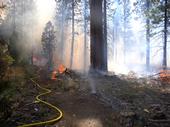
The massive die-off of conifers in the Sierra Nevada between 2012 and 2018 was predictable and unprecedented. Sadly, it is also likely to happen again, said UC Cooperative Extension forestry advisor Susie Kocher.
To help landowners manage forests in a way that minimizes the risk of such catastrophic tree die-off and the threat of uncontrolled wildfire, Kocher and two colleagues produced a 20-page publication that summarizes current research on tree mortality and outlines actions that can be taken to make the forest more resilient. The publication, Mass Tree Mortality, Fuels, and Fire: A Guide for Sierra Nevada Forest Landowners, is...
- Author: Jeannette E. Warnert
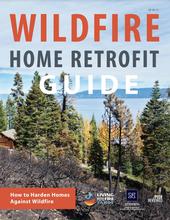
A team of California and Nevada fire scientists have produced a booklet with step-by-step guidance on retrofitting an existing home to be more resilient to fire.
Susie Kocher, UC Cooperative Extension forestry and natural resources advisor and co-author of the new guide, said some homeowners feel powerless to protect their homes against California's increasing wildfire threat.
“I'm happy to tell them that's not true. There are specific actions that we can all take to reduce the likelihood of our homes being burned in wildfire,” said Kocher, who lives in a forested area near Lake Tahoe. “We need to educate ourselves on the details of home construction that...



